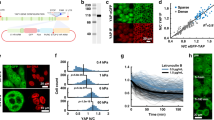Abstract
The human ST5 gene is expressed as 4.6, 3.1 and 2.8 kb transcripts encoding putative 126, 82 and 70 kDa proteins that function in the MAP kinase signaling pathway in transient expression assays. Expression of the 2.8 kb transcript correlates with reduced tumorigenicity in HeLa-fibroblast hybrids, suggesting a role in tumor suppression. We now report the detection of ST5 proteins in cellular extracts, demonstrate specific expression of p70 in non-tumorigenic HeLa-fibroblast hybrids, extend the correlation between p70 expression and cellular morphology to a wide variety of cell lines, and provide direct evidence that p70 can effect changes in cell growth and morphology. ST5 proteins were identified in extracts of human, mouse and simian epithelial cells and fibroblasts, but were absent from lymphoid cells. Transfection of the 2.8 kb cDNA into a p70-negative mouse fibroblast line yielded stable transfectants with a flattened, less refractile morphology relative to controls. The p70 expressing clones had initial growth rates similar to those of control cells but their saturation density was reduced threefold, suggesting a restoration of contact-regulated growth. In conjunction with previous findings, these results suggest that ST5 proteins participate directly in events affecting cytoskeletal organization and tumorigenicity.
This is a preview of subscription content, access via your institution
Access options
Subscribe to this journal
Receive 50 print issues and online access
$259.00 per year
only $5.18 per issue
Buy this article
- Purchase on Springer Link
- Instant access to full article PDF
Prices may be subject to local taxes which are calculated during checkout





Similar content being viewed by others
References
Ausubel FM. . 1994 In: Current Protocols in Molecular Biology, Volume 1, Chapter 9, Section 9.1 Greene Pub. Associates; J Wiley and Sons Inc: New York.
Bershadsky A, Chausovsky A, Becker E, Lyubimova A and Geiger B. . 1996 Curr. Biol. 6: 1279–1289.
Bohmer RM, Scharf E and Assoian RK. . 1996 Mol. Biol. Cell. 7: 101–111.
Davis RJ. . 1993 J. Biol. Chem. 268: 14553–14556.
Enomoto T. . 1996 Cell. Struct. Funct. 21: 317–326.
Kajstura J and Bereiter-Hahn J. . 1993 Cell. Biol. Int. 17: 1023–1031.
Lichy JH, Majidi M, Elbaum J and Tsai MM. . 1996 Nucleic Acids Res. 24: 4700–4708.
Lichy JH, Modi WS, Seuanez HN and Howley PM. . 1992 Cell Growth Differ. 3: 541–548.
Lu Q, Paredes M, Zhang J and Kosik K. . 1998 Mol. Cell. Biol. 18: 3257–3265.
Mainiero F, Murgia C, Wary KK, Curatola AM, Pepe A, Blumemberg M, Westwick JK, Der CJ and Giancotti FG. . 1997 EMBO J. 16: 2365–2375.
Majidi M, Hubbs AE and Lichy J. . 1998 J. Biol. Chem. 273: 16608–16614.
Noda M, Kitayama H, Matsuzaki T, Sugimoto Y, Okayama H, Bassin RH and Ikawa Y. . 1989 Proc. Natl. Acad. Sci. USA 86: 162–166.
Ren R Mayer BJ, Cicchetti P and Baltimore D. . 1993 Science 259: 1157–1161.
Rodriguez-Viciana P, Warne PH, Khwaja A, Marte BM, Pappin D, Das P, Waterfield MD, Ridley A and Downward J. . 1997 Cell 89: 457–467.
Stanbridge EJ and Wilkinson J. . 1980 Int. J. Cancer 26: 1–8.
Schievella AR, Chen JH, Graham JR and Lin LL. . 1997 J. Biol. Chem. 272: 12069–12075.
Sudhof TC. . 1997 Neuron 18: 519–522.
Taubenberger JK, Reid AH, Izon D and Boehme SA. . 1996 Cell Immunol. 171: 41–47.
Zhu J and Shore SK. . 1996 Mol. Cell. Biol. 16: 7054–7062.
Acknowledgements
The authors wish to acknowledge the assistance of K Bijwaard and Mark Tsai on various aspects of this work. This work was partially supported by Grant #RO1CA64114 from the NIH. The opinions or assertions contained herein are the private views of the authors and are not to be construed as official or as reflecting the views of the Department of the Army or the Department of Defense. This is a US Government work; there are no restrictions on its use.
Author information
Authors and Affiliations
Rights and permissions
About this article
Cite this article
Hubbs, A., Majidi, M. & Lichy, J. Expression of an isoform of the novel signal transduction protein ST5 is linked to cell morphology. Oncogene 18, 2519–2525 (1999). https://doi.org/10.1038/sj.onc.1202554
Received:
Revised:
Accepted:
Published:
Issue Date:
DOI: https://doi.org/10.1038/sj.onc.1202554



